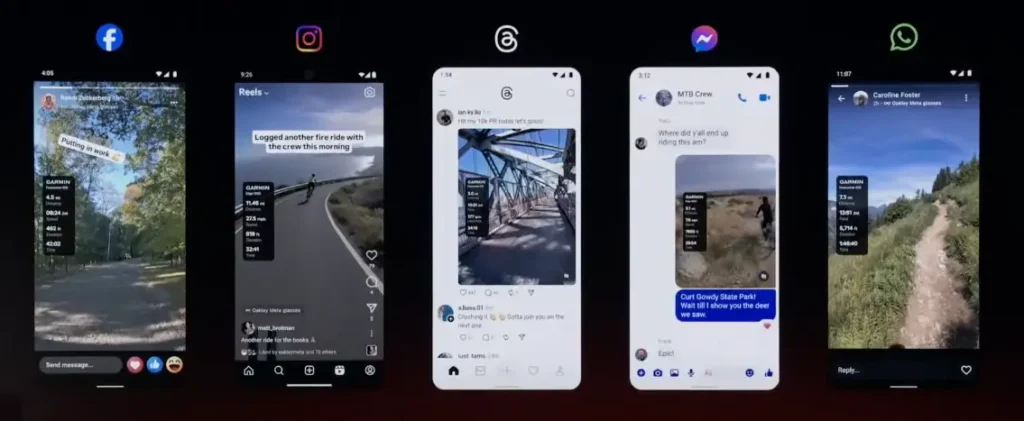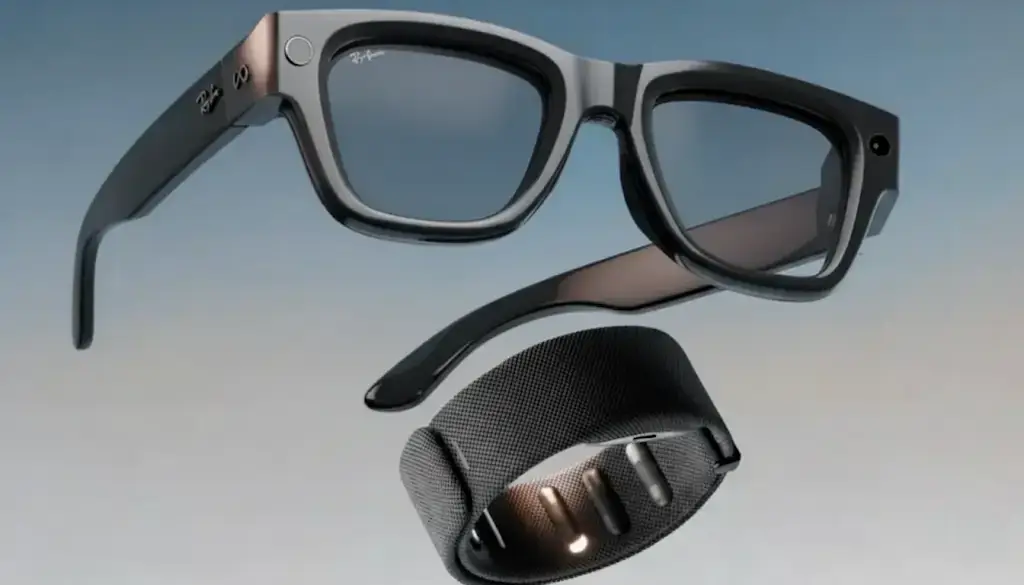Meta Smart Glasses Revolution: Mind-Driven Tech, Fashion-Forward Design
What Are Meta Smart Glasses, and Why Now?
Unveiled at Meta Connect 2025, Meta Smart Glasses combine neural input and stylish design to redefine wearables and hint at a post-smartphone future.
For years, tech companies have been trying to answer the same question: what comes after the smartphone? We’ve seen smartwatches, voice assistants, and even experimental AR headsets, but none have truly replaced the role our phones play in daily life. Now, Meta is making a bold move to change that. The company is turning our faces into the next user interface.
Meta Smart Glasses are not just a redesign of existing tech. They represent a shift in how we interact with the digital world. The experience is hands-free, screen-free, and increasingly seamless. By combining familiar eyewear designs with advanced neural input technology, Meta is creating something that feels less like a gadget and more like an extension of the human body.
This blog explores how Meta is reshaping the future of wearable technology through its smart glasses initiative. It will break down what makes these glasses different, how the Neural Band introduces a new level of mind-based control, and why partnerships with Ray-Ban and Oakley are critical to mainstream adoption. You will also get a clear look at what was revealed during Meta Connect 2025, along with an honest discussion about challenges like privacy and social acceptance.
By the end, it will become clear that Meta Smart Glasses are not just another wearable device. They could be the first serious step toward a world where we rely less on smartphones and more on intuitive, invisible tech that fits into everyday life.
1. The Evolution of Smart Glasses: From Gimmick to Game-Changer
When Smart Glasses Were Just a Joke
For most of the past decade, smart glasses struggled to gain mainstream acceptance. Google Glass launched with huge expectations in 2013 but quickly faded from public interest. The product looked awkward, raised privacy concerns, and lacked a clear purpose. Other companies released similar products, including Snap Spectacles and Amazon Echo Frames, but none found lasting success.
The core issue was that early smart glasses felt like technology for technology’s sake. They didn’t solve real problems and often introduced new ones. Wearing them in public made users feel uncomfortable. The hardware was too visible, the controls felt unnatural, and the experience didn’t justify the effort.
What Meta Did Differently
Meta approached the challenge with a different mindset. Instead of focusing only on technical features, the company emphasized wearability and user experience. The design was developed in collaboration with Ray-Ban and Oakley, two well-known fashion eyewear brands. As a result, the glasses look like something you might already wear—not a gadget strapped to your face.
This simple shift in design philosophy changed everything. People are far more likely to try a smart device if it feels familiar and fits their lifestyle. Meta Smart Glasses are designed to blend in, not stand out, which makes them easier to adopt and less intimidating to wear in public.
The Real Breakthrough in Interaction
Good design invites people to try the product, but seamless interaction is what keeps them using it. Earlier smart glasses relied heavily on voice commands or touch-sensitive frames. These input methods can be awkward, especially in social situations.
Meta addressed this limitation with the introduction of the Neural Band. This wrist-worn device detects electrical signals from your muscles and interprets your intent before you physically move. You can silently control the glasses with small, nearly invisible gestures. There is no need to speak, swipe, or tap anything. This innovation makes interaction with Meta Smart Glasses feel natural, private, and nearly effortless.
Smart Glasses With a Purpose
Until recently, smart glasses lacked clear use cases. They often felt like expensive toys with limited value. That perception is changing with the arrival of Meta Smart Glasses. Whether you’re capturing a photo while biking, listening to directions while walking, or skipping a song with a finger movement, these features solve actual everyday problems.
Meta isn’t trying to replace the smartphone all at once. Instead, it’s creating a product that complements the smartphone by filling in the gaps where phones are inconvenient or inaccessible. In doing so, Meta is not just making better smart glasses. It is redefining what it means for technology to be truly wearable.
2. Neural Band Technology: Thought-Controlled Interfaces Arrive
What the Neural Band Is and How It Works
The Neural Band is a wrist-worn wearable device that connects with Meta Smart Glasses to offer a completely new form of interaction. Instead of using voice or touch, it reads electrical signals from your muscles using a method called electromyography, or EMG. These signals are created when your brain sends instructions to move, even if no visible movement occurs.
By capturing these signals at your wrist, the Neural Band can understand what you intend to do. You can trigger actions with slight, invisible gestures. A simple thought to move your finger is enough to control the glasses without any physical input.
Why This Interface Matters
Most wearables depend on touchscreens or voice commands. These controls can be slow, inconvenient, or socially uncomfortable. Voice input does not work well in noisy environments, and touch-sensitive frames are often awkward to use on the go.
The Neural Band solves these issues by providing a private and intuitive way to control Meta Smart Glasses. You do not need to speak or physically interact with the device. Instead, your intention is enough. This makes everyday tasks like replying to messages, starting a recording, or adjusting volume feel fast, natural, and almost invisible.
Learning and Adapting to You
What makes the Neural Band even more impressive is its ability to learn. Over time, it adapts to your unique muscle signals and improves its accuracy. The more you use it, the better it becomes at predicting and recognizing your actions.
This process turns a general-purpose controller into a personalized input system. You are not forced to learn complex gestures or commands. The system adjusts itself to match your natural behavior, making the experience more efficient and more human.
A Glimpse Into the Future
The Neural Band offers more than just convenience. It introduces a completely different way of thinking about how we use technology. Instead of tapping or swiping, interaction begins with intent. This shift could eventually reduce our dependence on screens, buttons, and even voice commands.
Meta Smart Glasses demonstrate how this new form of input can work in real life. The combination of wearable design, hands-free functionality, and thought-based control points to a future where devices respond to us in ways that feel effortless and intuitive. This is not just about what technology can do. It is about how naturally it can fit into our lives.
3. Ray-Ban, Oakley, and the Rise of Fashion-Forward Wearables
Why Design Matters More Than Ever
For wearable tech to succeed, it has to be something people actually want to wear. This has been one of the biggest challenges in the industry. Early smart glasses looked bulky, unfamiliar, and frankly unattractive. Even if the tech was impressive, the design turned people away before they ever tried it.
Meta approached this differently. Instead of creating a tech product and trying to make it stylish later, they partnered from the beginning with brands that understand real-world design. Ray-Ban and Oakley brought decades of experience in making eyewear people already love. The result is a product that looks familiar, feels natural, and avoids the “tech toy” aesthetic that many earlier devices couldn’t escape.
How Meta and Ray-Ban Got It Right
The first thing you notice about Meta Smart Glasses is that they don’t stand out. That’s a good thing. They are designed to blend into your style, not call attention to themselves. They come in classic Ray-Ban frame styles like the Wayfarer, and newer models are also expanding into sportier looks through the Oakley partnership.
These glasses don’t just look good. They feel like normal glasses when you wear them. They are lightweight, balanced, and surprisingly discreet considering the tech inside. Cameras, microphones, and speakers are all carefully embedded to maintain the aesthetic without sacrificing function. It’s a rare case where form and function are truly in sync.
The Role of Oakley in the Athlete Market
Oakley’s involvement opens the door for a very different kind of user. While Ray-Ban focuses on everyday wearers, Oakley targets athletes, runners, and outdoor enthusiasts. This version of Meta Smart Glasses is built for performance, with features like sweat resistance, real-time fitness metrics, and Garmin integration.
For users who are active or constantly on the move, smart glasses need to do more than look good. They need to stay in place, survive the elements, and deliver information quickly and clearly. Oakley brings that capability while still aligning with Meta’s broader goal of making tech feel wearable and invisible.
Why Fashion-Forward Wearables Are the Future
The success of Meta Smart Glasses depends not only on what they can do, but on how naturally they fit into people’s lives. A wearable device needs to feel like part of your wardrobe, not a statement piece of technology. Ray-Ban and Oakley help accomplish that by grounding futuristic features in familiar designs.
This shift in strategy marks an important turning point. In the past, wearables asked users to adapt to the product. Now, the product is adapting to the user. It blends into your lifestyle, supports your routines, and disappears when you’re not using it. That’s the future of wearable tech, and Meta Smart Glasses are leading the way.
4. What Meta Smart Glasses Can Actually Do
Hands-Free Photo and Video Capture
Meta Smart Glasses are designed to let you capture real-life moments effortlessly. With a built-in camera, you can take high-resolution photos or record 3K Ultra HD video using just subtle gestures or neural input via the Neural Band. There’s no need to pull out your phone, stop what you’re doing, or even make noticeable movements. This is especially useful during active moments like biking, hiking, or working out—times when grabbing a phone would disrupt the experience.
For creators and everyday users alike, this means truly spontaneous content is now possible.
Seamless Sharing Across Meta Apps
What makes these glasses even more powerful is how seamlessly they connect to Meta’s entire ecosystem. Once a photo or video is captured, you can instantly share it on Facebook, Instagram, Threads, Messenger, or WhatsApp—all directly from the Meta Smart Glasses interface.
The image below, shown during Meta Connect 2025, captures exactly how this works in real life. It features a set of fitness videos captured with the Oakley Meta Vanguard and shared across multiple platforms. Each clip displays real-time Garmin performance metrics such as distance, elevation, speed, and time—making it ideal for athletes, fitness influencers, and outdoor enthusiasts.

Real-Time Audio and Smart Control
Alongside visual capture, Meta Smart Glasses offer immersive audio features. Built-in speakers let you listen to music, take calls, or hear messages without wearing earbuds. The open-ear design keeps you aware of your surroundings, making it safe and practical for city streets or outdoor trails.
Voice control is available, but the addition of the Neural Band takes interaction even further. You can issue commands, navigate menus, or trigger actions with just a subtle muscle movement—without speaking or touching anything. This makes the glasses feel like an intuitive extension of your body.
Built for Real Life
Meta Smart Glasses are not overloaded with gimmicks. Instead, they focus on doing a few things exceptionally well: capturing content, delivering audio, and responding to natural input. These features aren’t meant to replace your phone overnight, but they make the phone less necessary in more situations.
Whether you’re sharing a workout with Garmin data, listening to directions while walking, or answering a call on the go, the experience is simple and fluid. This is what wearable tech should feel like—practical, invisible, and seamlessly connected to your digital world.
5. Meta Connect 2025: Key Announcements You Need to Know
A New Lineup of Wearable Tech
At Meta Connect 2025, the company introduced its most ambitious lineup of smart glasses yet. The announcement wasn’t just about new features, but about how wearable technology is beginning to mature into something practical and desirable. Meta Smart Glasses were at the center of this reveal, supported by major updates in both hardware and software.
The event showcased three main products. Each is aimed at a specific type of user, with different strengths depending on lifestyle and needs. These are no longer experimental prototypes. They are consumer-ready products designed to integrate into real life.
Ray-Ban Meta Smart Glasses Gen 2
The second-generation Ray-Ban model was one of the most anticipated updates. It now offers double the battery life, lasting up to eight hours on a single charge. The camera has been upgraded to record 3K Ultra HD video, which is a major step up for creators and vloggers.
Another standout feature is Conversation Focus. This audio enhancement allows the glasses to isolate and amplify voices in noisy environments, making it easier to hear people on calls or during recordings. It is a feature designed for real-world use, especially in cities, events, or crowded spaces.
Display Glasses and the Neural Band
One of the more futuristic products revealed was a pair of display-enabled glasses that work directly with the Neural Band. This pairing allows users to navigate menus, send messages, or interact with digital content using subtle wrist gestures. The system can detect muscle signals before any physical movement occurs, offering one of the most advanced control interfaces ever built into a wearable device.
The Neural Band continues to adapt to the user over time, creating a personalized control experience that feels more like thought-based input than traditional gesture control.
Oakley Meta Vanguard for Athletes
For more active users, Meta introduced the Oakley Meta Vanguard. These smart glasses are built with fitness and performance in mind, offering sweat resistance, nine-hour battery life, and real-time data tracking through Garmin integration.
They are designed for runners, cyclists, and athletes who need on-the-go access to information without stopping or pulling out a phone. With Oakley’s performance-driven frame designs and Meta’s tech infrastructure, this product expands the smart glasses category beyond casual use.

More Than Just Hardware
Meta Connect 2025 also emphasized its long-term vision. These products are not standalone gadgets. They are part of a growing ecosystem where smart wearables, neural input, and AI assistants all work together. Meta is building a future where interaction with technology feels more human, more fluid, and less visible.
Meta Smart Glasses are no longer a concept or a prototype. They are now a core part of the company’s product strategy. With real use cases, better design, and powerful integrations, these glasses mark a shift in how we’ll interact with digital tools in the years ahead.
6. Challenges Ahead: Privacy, Social Acceptance, and Tech Skepticism
The Privacy Question
As exciting as Meta Smart Glasses may be, they also raise serious questions about privacy and surveillance. With built-in cameras and microphones, these glasses can record or capture information without others realizing it. This creates tension in public and social spaces, especially when people are unaware they are being filmed.
Meta has made efforts to address this concern. There are visible indicators like recording lights and audible signals, but they are small and easy to miss. The challenge is finding the balance between usability and transparency. Users want seamless recording, but the people around them want to feel safe and respected.
Social Norms and Public Use
Another obstacle is social acceptance. Even with improved design, some people are still uncomfortable around wearables that include cameras or audio features. In some environments, wearing Meta Smart Glasses can feel intrusive, even if no recording is taking place.
Adoption will depend on how quickly social norms evolve. Just as people gradually accepted smartphones and AirPods in public, smart glasses may follow a similar path. However, that shift will take time and will require clear communication about what the glasses are doing at any given moment.
Tech Fatigue and Consumer Trust
Many consumers are also approaching new tech with growing skepticism. Concerns about data collection, battery safety, software bugs, and long-term support are now top of mind. Meta, in particular, has faced public trust issues in the past, which means the company must work harder to convince users that this new product category is worth embracing.
Success will depend not just on how advanced Meta Smart Glasses are, but on how responsibly they are introduced. This includes setting clear boundaries, offering strong privacy settings, and being transparent about how user data is handled.
Not Just About the Technology
The biggest hurdle may not be the hardware or the interface. It is the perception of what this technology represents. Smart glasses are visible, wearable, and always connected. They blur the line between personal tech and public behavior. That makes people pause, question, and resist—even when the features are useful.
To overcome this, Meta will need to invest in more than product development. It will need to educate, listen, and build genuine trust with its users. Without that, even the most impressive features may not be enough to drive widespread adoption.
7. Are Meta Smart Glasses the Future Beyond Smartphones?
Filling in the Gaps, Not Replacing the Phone (Yet)
Meta Smart Glasses are not positioned as full smartphone replacements. At least, not yet. What they do instead is fill in the gaps where phones fall short. You can record a moment without taking out your device, listen to music without headphones, or get directions without looking at a screen. These are small changes, but they start to shift how we think about interacting with digital tools.
By reducing our dependence on screens and freeing up our hands, smart glasses allow for more fluid and ambient computing. Instead of forcing a task to fit a phone, the technology adapts to the situation. Over time, this could lead to a redefinition of what a “primary device” even means.
A New Category That Could Evolve Quickly
The idea of smart glasses replacing smartphones might still feel distant, but so did the smartphone itself just two decades ago. What makes Meta Smart Glasses unique is the pace at which the supporting technology is improving. Neural input, voice control, spatial audio, and lightweight design are all evolving together. This creates the possibility of a product that not only coexists with phones but eventually starts to replace core functions.
Messaging, calling, navigation, photography, and audio playback can already be done through the glasses. As the ecosystem around them matures, it is easy to imagine a future where you leave your phone behind entirely in many situations.
Barriers to Full Adoption Still Remain
Despite the potential, there are still challenges to overcome. Screen-based tasks like reading, writing, and complex browsing are not yet realistic on Meta Smart Glasses. Battery life, app integration, and network dependence are also factors that limit full replacement.
There is also the question of whether people are ready to wear their primary device on their face. Even with strong design and growing interest in wearables, adoption will take time. Cultural shifts do not happen overnight, and new categories need to earn trust.
A Step Toward the Post-Smartphone Era
What we are seeing is not the end of smartphones, but the beginning of something new. Meta Smart Glasses represent the first serious attempt to move computing off the screen and into the world around us. They are not just about adding convenience. They are about changing the relationship between humans and technology.
As the product evolves and becomes more capable, the line between phone and wearable will continue to blur. The next big shift in personal tech may not come from a new phone model. It may come from a pair of glasses that respond to what you want before you say or do anything at all.
8. Conclusion: A New Era of Wearable Tech Has Arrived
Meta Smart Glasses are not a futuristic concept anymore. They are a real product available today, blending fashion, functionality, and advanced control into a single, wearable device. With the integration of the Neural Band, Meta has introduced a new way to interact with technology that goes beyond touchscreens and voice commands. It begins with intent and ends with seamless action.
This isn’t just an upgrade to smart glasses. It is a step toward a future where digital tools respond to us more naturally, without requiring our constant attention or physical input. From hands-free photography and real-time audio to muscle-based control and adaptive learning, the product has set a new standard for what wearables can be.
Of course, challenges still exist. Privacy concerns, cultural resistance, and technical limitations will continue to shape how the public responds to these devices. But the direction is clear. Meta is not just experimenting. It is investing in the long game.
Whether or not Meta Smart Glasses eventually replace the smartphone, they have already changed the conversation. They prove that wearable tech does not have to be bulky, awkward, or limited. It can be stylish, useful, and even invisible when it needs to be.
As adoption grows and the technology matures, Meta’s glasses may be remembered as the first real step toward the post-smartphone era. Not by removing the phone from your life all at once, but by quietly making you reach for it less and less.
🔑 Meta Keywords
Meta Smart Glasses, Meta Neural Band, and Meta smart glasses features. You’ll also want to include Ray-Ban Meta glasses and Oakley Meta Vanguard to capture search interest around the specific models. Broader keywords like wearable technology 2025, future of wearable tech, and next-gen wearable devices help target readers interested in the category as a whole. Long-tail keywords such as thought controlled smart glasses, mind controlled wearables, and neural interface technology can bring in traffic from more specific searches. Supporting phrases like Meta Connect 2025, smart glasses for creators, AI powered glasses, Meta AR glasses, and tech fashion innovation further connect the post to relevant searches. Including Meta smart eyewear and augmented reality smart glasses helps cover the broader landscape of related terms, increasing visibility across multiple search queries.







